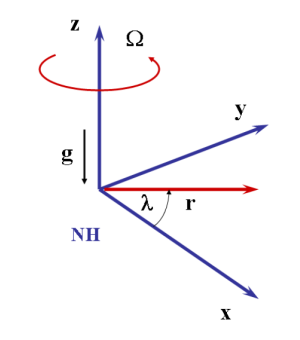
To a good first approximation the mature tropical cyclone consists of a horizontal quasi-axisymmetric circulation on which is superposed a thermally-direct transverse (overturning) circulation. These are sometimes referred to as the "primary circulation'' and "secondary circulation'', respectively. The former refers to the tangential or swirling flow rotating about the central axis, and the latter to the "in-up-and-out circulation" (low and middle level inflow, upper-level outflow). When these two components are combined, the picture emerges of air parcels spiralling inwards, upwards and outwards. The combined spiralling circulation is called energetically direct because the rising branch of the secondary circulation near the centre is warmer than the subsiding branch, which occurs at large radial distances (radii > 500 km). When warm air rises (or cold air sinks), potential energy is released.
Here we examine some basic aspects of the dynamics of the spiralling circulation of tropical cyclones on the basis of the physical laws governing fluid motion and thermodynamic processes that occur. For simplicity, we study first the dynamics of a stationary (non-moving) axisymmetric hurricane-like vortex. Later we will consider the dynamics of tropical-cyclone motion and examine also several very important asymmetric features of storms that arise either intrinsically or in association with the interaction of the vortex with its larger-scale atmospheric and/or oceanic environment.
We start by giving an overall picture of the dynamics and then cover in more detail several particularly important aspects. First we introduce the governing equations without making the assumption of axial symmetry.
Some basic properties of vortical flows of variable density that are relevant to tropical cyclones may be elucidated by considering the full equations of motion in a rotating coordinate system in cylindrical polar coordinates, (r,λ,z). The configuration envisioned is that of an f-plane in which the flat lower surface rotates with a uniform rotation rate Ω = ½f, which is the local vertical rotation rate of the earth at latitude φ. The gravitational force per unit mass bold g = (0,0,-g) is assumed here to point in the direction opposite to z, where g is the acceleration due to gravity. The basic setup is sketched in Fig. 3.1.

The primitive equations of motion comprising the momentum equations, the continuity equation, the thermodynamic equation and the equation of state for frictionless motion on the f-plane may be expressed as follows:
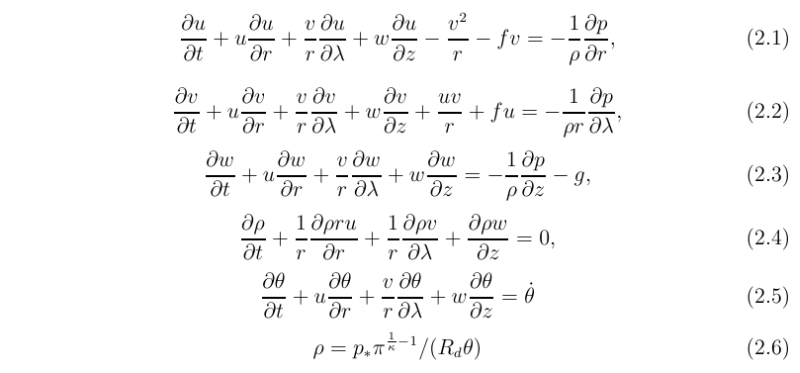
where u, v, w are the Eulerian velocity components in the three orthogonal coordinate directions, θ-dot is the diabatic heating rate (1/{cpπ})D dot θ/Dt, and π =(p/p*)κ is the Exner function. Temperature is given by T = πθ.
Multiplication of Eq. (3.2) by r and recalling that u = Dr/Dt leads to the equation

where

is the absolute (vertical) angular momentum per unit mass of an air parcel about the rotation axis. If the flow is axisymmetric (and frictionless), the right-hand-side of (3.7) is zero and the absolute angular momentum is materially conserved as rings of air move radially, i.e.,

where

is the material derivative operator for axisymmetric flow. Apart from a factor of 2π, M is equivalent to Kelvin's circulation, Γ, for a circle C of radius r enclosing the centre of circulation, i.e., 2πM = Γ = ∫C vabs ⋅ dl, where vabs is the absolute velocity and dl is a differential line segment along the circle. The material conservation of M is equivalent to Kelvin's circulation theorem.
Important aspects of the basic structure of a mature tropical cyclone can be deduced from two simple equations that express an exact balance of forces in the vertical and radial directions. These equations enable one to develop a simple theory for the primary circulation. The equations are obtained directly from (3.1) - (3.6) assuming steady (∂/∂t ≡ 0), axisymmetric (∂/∂λ ≡ 0) flow with no diabatic heating (θ-dot; = 0) and no secondary circulation (u = 0, w = 0). In this case Eqs. (3.1) and (3.3) give,

and

while Eqs. (3.2) and (3.4) are identically satisfied. Equations (3.11) and (3.12) apply to any steady, inviscid, freely-spinning circular vortex. Equation (3.11) expresses a balance between the radial pressure gradient and the centrifugal and Coriolis forces, each per unit mass, a state that we refer to hereafter as gradient wind balance. We call this equation the gradient wind equationhydrostatic equation. The complete balance of forces is shown schematically in Fig. 3.2. A scale analysis carried out later shows that the gradient wind equation and hydrostatic equation provide a good first approximation for representing the primary circulation of tropical cyclones, even in the presence of modest diabatic heating and a nonzero, but relatively weak secondary circulation. Support for gradient wind balance is found also in analyses of aircraft observations in hurricanes.
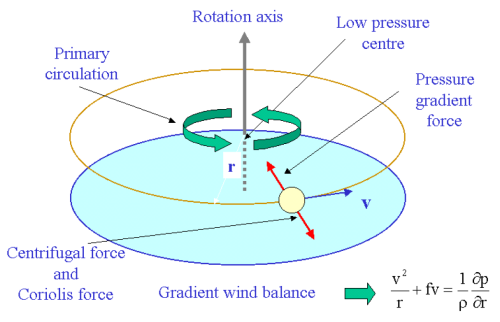
Taking (∂/∂z)[ρ × Eq. (3.11)] and (∂/∂r)[ρ × Eq. (3.12}] and eliminating the pressure we obtain the thermal wind equation

where

denotes the sum of the centrifugal and Coriolis forces per unit mass. Equation (2.13) is a linear first-order partial differential equation for ln ρ. The characteristics of the equation satisfy

The characteristics coincide with the isobaric surfaces because a small displacement (dr, dz) along an isobaric surface satisfies (∂p/∂r)dr + (∂p/∂z)dz = 0. Then, using the equations for hydrostatic balance (∂p/∂z = - gρ) and gradient wind balance (∂p/∂r = Cρ) gives the equation for the characteristics. Alternatively, note that the pressure gradient per unit mass, (1/ρ)(∂p/∂r, 0, ∂p/∂z) equals (C,0,-g), which defines the "generalized gravitational vector", g*. Thus the isobars are normal to this vector: see Fig. 3.3 The density variation along a characteristic is governed by the equation

Given the vertical density profile, ρa(z), Eqs. (3.15) and (3.16) can be integrated inwards along the isobars to obtain the balanced axisymmetric density and pressure distributions. In particular, Eq. (3.15) gives the height of the isobaric surface that has the value pa(z), say, at radius R.
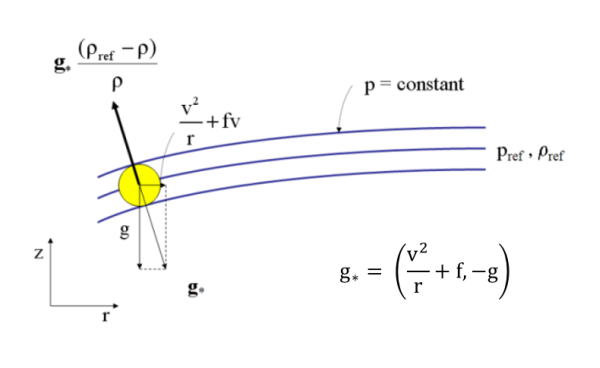
Since ∂C/∂z = (2v/r + f)(∂v/∂z), it follows from (3.16) that for a barotropic vortex (∂v/∂z = 0), ρ is constant along an isobaric surface, i.e. ρ = ρ(p), whereupon, from the equation of state (p = ρRT), T is a constant also, or more generally Tρ if the air contains water substance.
The thermal wind equation is a form of the toroidal vorticity equation (the equation for the tangential component of vorticity: see section 3.10.1) and can be interpreted as a balance between the tendency of three effects (Fig. 3.4). The first term is a positive vorticity tendency associated with the propensity of warm air to rise and cool air to sink in the presence of a gravitational field acting downwards. The second term is a negative vorticity tendency associated with the propensity of warm air to be centrifuged radially inwards and cool air to be centrifuged radially outwards in the presence of a centrifugal force field acting outwards. The third is a negative vorticity tendency associated with the decrease of the generalized Coriolis force with height associated with the negative vertical shear of the tangential wind component.
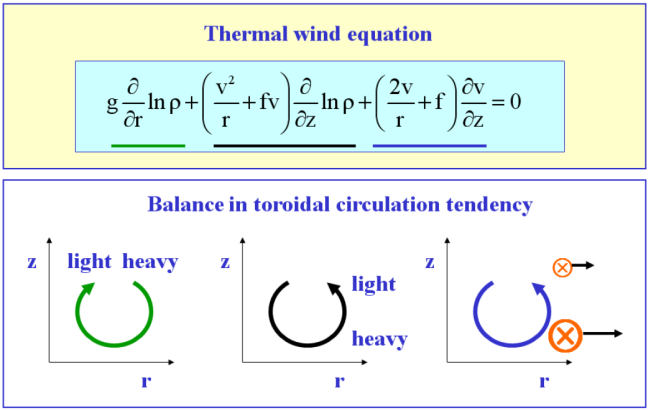
The thermal wind equation (3.13), or equivalently Eq. (3.16), show that in a cyclonic vortex in the Northern Hemisphere (v > 0), in which the tangential wind speed decreases with height (∂v/∂z < 0), ln ρ and hence ρ decrease with decreasing radius along the isobaric surface. Thus the temperature and potential temperature increase as r decreases and the vortex is warm cored (i.e. ∂T/∂r < 0). This prediction of the thermal wind equation is consistent with the observation that tropical cyclones are warm-cored systems and that the tangential wind speed decreases with altitude. If the tangential wind speed were to increase with height (∂v/∂z > 0) the vortex would be cold cored. Note that the characteristics, or isobars, dip down as the axis is approached on account of Eq. (3.15). The reason for the warm core structure of tropical cyclones is discussed later.
Figure 3.5 shows an example of a calculation using the foregoing theory. The tangential wind field in Fig. 3.5a is broadly typical of that in a tropical cyclone. It is used to calculate the pressure field, shown also in this figure, as well as the density and temperature fields. The density field and the difference in temperature from that at large radii are shown in Fig. 3.5b. Note that the isobars as well as the density contours dip down near the vortex axis. Temperatures in the vortex core region are mostly warmer than in the environment at the same height, except at low levels where they are cooler.

The analysis above shows that any steady vortical flow with velocity field u = (0,v(r,z),0) is an exact solution of the equation set (3.1) - (3.6), when the density field satisfies (3.12). The observational evidence that the primary circulation of a hurricane is approximately in gradient wind balance makes the foregoing analysis a good start in understanding the structure of this circulation. However the solution neglects the secondary circulation associated with nonzero u and w and it neglects the effects of condensational heating, radiative cooling and of friction near the sea surface. These are topics of subsequent subsections.
Assuming the most general form of the mass conservation equation:

show that the absolute angular momentum per unit volume,

satisfies the equation:

Show that Eq. (3.13) may be reformulated as

where χ = 1/θ.
Show that in terms of the Exner function, Eqs. (3.10) and (3.11) may be written as

respectively.
The expression for buoyancy (1.25) is valid also in a rapidly rotating vortex, but as shown in section 3.2, there exists then a radial component of buoyancy as well. When clouds are involved it may be advantageous to include the drag of hydrometeors in the definition of buoyancy. This may be done by using the density temperature given by Eq. (1.18) in place of the temperature for dry air, or the virtual temperature for moist air.
In a rapidly-rotating, axisymmetric vortex, an air parcel experiences not only the gravitational force, but also the radial force C = v2/r + fv, where v is the tangential wind component at radius r. If the vortex is in hydrostatic and gradient wind balance, the isobaric surfaces slope in the vertical and are normal to the effective gravity, g* = (C,0, -g), expressed in cylindrical coordinates (r, λ, z) (see Fig. 3.2). The Archimedes force acting on the parcel is then -g*ρref and the effective weight of the parcel is g*ρ, where ρref is now the far-field (reference-) density along the same isobaric surface as the parcel. Accordingly, we may define a {generalized buoyancy force per unit mass:

analogous to the derivation of (1.25). Note that unless v(v+rf) < 0, air parcels that are lighter than their environment have an inward-directed component of generalized buoyancy force as well as an upward component, while heavier parcels have an outward component as well as a downward component. (If v(v+rf) < 0, C is directed inwards. Then, in the Northern Hemisphere, -rf < v < 0, i.e. the tangential flow is anticyclonic and relatively weak.) This result provides the theoretical background for a centrifuge. A centrifuge is a device used to separate lighter from heavier substances by rotating them rapidly in some container.
Observations show that the eye is a cloud free region surrounding the storm axis where the air temperatures are warmest. Therefore, it would be reasonable to surmise that the air within it has undergone descent during the formative stages of the cyclone, and that possibly it continues to descend. The question then is: why doesn't the inflowing air spiral in as far as the axis of rotation. We address this question later, but note here that eye formation is consistent with other observed features of the tropical cyclone circulation. Assuming that the primary circulation is in gradient wind balance, we may integrate Eq. (\ref{eq3.10}) with radius to obtain a relationship between the pressure perturbation at a given height z on the axis to the tangential wind field distribution, i.e:

where pa(z) = p(∞,z) is the environmental pressure at the same height. Differentiating Eq. (3.19}) with respect to height and dividing by the density gives the perturbation pressure gradient per unit mass along the vortex axis:

Observations in tropical cyclones show that the tangential wind speed decreases with height above the boundary layer and that the vortex broadens with height in the sense that the radius of the maximum tangential wind speed increases with altitude (see Fig. 2.11). This behaviour, which is consistent with outward-slanting absolute angular momentum surfaces as discussed above, implies that the integral on the right-hand-side of Eq. (\ref{eq3.19c}) decreases with height. Then Eq. (\ref{eq3.19c}) shows that there must be a downward-directed perturbation pressure gradient force per unit mass along the vortex axis. If unopposed, this perturbation pressure gradient would drive subsidence along and near to the axis to form the eye. However, as air subsides, it is compressed and warms relative to air at the same level outside the eye and thereby becomes locally buoyant (i.e. relative to the air outside the eye). In reality this upward buoyancy approximately balances the downward directed (perturbation) pressure gradient so that the actual subsidence results from a small residual force. In essence the flow remains close to hydrostatic balance.
As the vortex strengthens, the downward pressure gradient must increase and the residual force must be downwards to drive further subsidence. On the other hand, if the vortex weakens, the residual force must be upwards, allowing the air to re-ascend. In the steady state, the residual force must be zero and there is no longer a need for up- or down motion in the eye, although, in reality there may be motion in the eye associated with turbulent mixing across the eyewall or with asymmetric instabilities within the eye.
It is not possible to measure the vertical velocity that occur in the eye, but one can make certain inferences about the origin of air parcels in the eye from their thermodynamic characteristics, which can be measured.
The above arguments are incomplete as they are based on the assumption of exact balance and cannot account for the residual force. The theory based on the Sawyer-Eliassen equation in section 3.7 provides a more complete way of understanding the formation of the eye.
The key element of vortex spin up in an axisymmetric setting can be illustrated from the equation for absolute angular momentum per unit mass, Eq. (3.7). If the frictional torque per unit mass, rFλ, acting on a fluid parcel is zero, then M is materially conserved, (see Eq. (3.9)). Since M is related to the tangential velocity by the formula (3.8}:

we see that, when M is materially-conserved, both terms in this expression lead to an increase in v as r decreases and to a decrease in v when r increases. Thus a prerequisite for spin up in an inviscid axisymmetric flow is azimuthal-mean radial inflow. Conversely, as air parcels move outwards, they spin more slowly. An alternative, but equivalent interpretation for the material rate-of-change of the mean tangential wind in an axisymmetric inviscid flow follows directly from Newton's second law (see Eq. (3.2)) in which the sole force is the generalized Coriolis force, -u(v/r + f). Either viewpoint shows that spin up (or spin down) is related to the radial motion of air parcels and therefore depends on the secondary circulation, which will be examined below.
In regions where frictional forces are appreciable, Fλ is negative definite (provided that the tangential flow is cyclonic relative to the Earth's local angular rotation, v/r > -½f, and M decreases following air parcels. However, we will show later that friction plays an important dynamical role in the spin up of a tropical cyclone.
Since the theory for the steady primary circulation in section 3.2 was derived on the assumption that there was no secondary circulation (u ≈ 0, w ≈ 0), it is necessary
to examine the applicability of this theory when a secondary circulation exists. To this end we perform a scale analysis of the dynamical equations (3.1) - (3.3} and continuity equation (3.4).
It suffices to assume that the air is homogeneous and frictionless and that the motion is axisymmetric. In later chapters we redo this analysis for flows in which friction is important. We
define velocity scales (U,V,W) for (u,v,w), length scales (R,Z) for (r,z), a time scale T for t, a scale Δp for changes in pressure, p. We define two nondimensional parameters: a
swirl parameter Sp = U/V and a Rossby number Ro = V/(fR). We assume also an advective time scale for the secondary circulation
T = R/U. (for axisymmetric motions the time-scale R/V is not relevant). Then the terms in Eqs. (3.1} to (3.4} have scales as shown in Table 1.

From line (1) in Table 1 we see that the continuity equation (3.4} implies that W/Z = U/R, a result that is used to simplify the scalings. We divide terms in line (2a) by V2/R to obtain those in line (2b) and divide terms in line (3a) by V2/R to obtain those in line (3b). The terms in line (4a) are divided by g to obtain those in line (4b). The terms in lines (b) are then nondimensional.
It follows from line (2b) in Table 1 that for low swirl ratio, Sp << 1, the radial momentum equation is closely approximated by the gradient wind equation (Note that if the pressure term had a larger order of magnitude than the sum of the centrifugal and Coriolis terms, it would drive a radial acceleration that would eventually violate the assumption that Sp << 1. Line (3b) in the table shows that all the nonlinear terms in the azimuthal momentum equation are of the same order of magnitude. These are dominant if Ro >> 1, but the Coriolis term is of equal importance\footnote{We cannot argue that it is dominant, since then the other terms would be negligible, but then we would conclude that fu = 0 if Ro << 1.
Line (4b) in Table 1 shows that the ratio of the acceleration terms in the vertical momentum equation to the gravitational acceleration is WU/(Rg). Typical scales for a tropical cyclone are U ≤ 20 m s-1, W ≤ 1 m s-1, R ≥ 50 km and g ≈ 10 m s-2. Then WU/Rg ≤ 4 × 10-5. We conclude that the motion on these scales is very close to hydrostatic balance with the vertical pressure gradient term in the momentum equation balancing the gravitational acceleration, i.e. Eq. (3.3) is closely approximated by (3.10}. This means that the theory for the primary circulation worked out in section 3.2 should be a good approximation to reality.
If the vortex is axisymmetric and in approximate gradient wind and hydrostatic balance, we can derive an equation for the streamfunction, ψ, of the secondary circulation, i.e. the circulation in a vertical plane. This streamfunction is such that

which ensures that the continuity equation (3.4), is satisfied. The equation for φ follows by differentiating the thermal wind equation in the form (3.17} with respect to time t and using the azimuthal momentum equation and thermodynamic equation to eliminate the time derivatives. It is convenient to write the last two equations in the form

where ζ = (1/r)(∂(rv) /∂r) is the relative vorticity and we have added a momentum source term V-dot in the former equation for reasons that will emerge later. The time derivative of (3.13) is

and substitution of the time derivatives from (3.24} and (3.25} gives

where

Then

or

using (3.18). Then substitution for u and w from Eqs. (3.23} into Eq. (3.26} gives

This linear second-order partial differential equation is called the Sawyer-Eliassen equation following the work of these two authors.
The discriminant of the Sawyer-Eliassen equation is

It can be shown that Eq. (3.28) is elliptic if D > 0 and therefore requires suitable boundary conditions along athe entire closed boundary of the domain of interest.
The Sawyer-Eliassen equation contains three spatially-varying parameters characterizing:
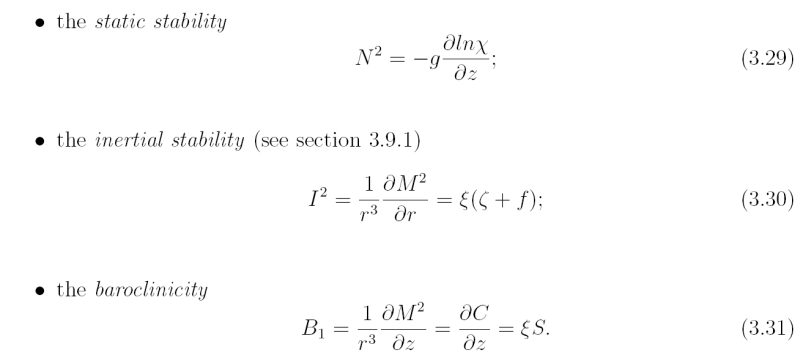
Desite the variation of the coefficients, the membrane analogy may be useful in providing a qualitative understanding of the local character of the solutions (see Appendix B of my Advanced Dynamical Meteorology lecture notes).
It is instructive to examine the solutions of the Sawyer-Eliassen equation for point sources (i.e. azimuthal rings) of heat and azimuthal momentum. Such solutions are shown schematically in Fig. 3.6. The flow through the heat source follows a nearly vertical surface of constant absolute angular momentum, while that for a momentum source follows a nearly horizontal isentropic surface. For sources of heat and absolute angular momentum, the sense of the flow is upward and outward, respectively. For sinks the flow is reversed. The vortex axis lies to the left of the figure. In the warm-core system of panels (c) and (f), the warm anomaly that supports the slope of the constant absolute angular momentum and isentropic surfaces increases towards the upper left.
Figure 3.7 shows the secondary circulation induced by point sources of heat and absolute angular momentum in balanced, tropical-cyclone-like vortices in a partially bounded domain. These solutions can be obtained using the so-called method of images. Again the secondary circulation through a heat source is primarily vertical, and that through a momentum source is primarily horizontal. The streamlines form two counter-rotating cells of circulation (or gyres) that extend outside the source. There is a strong flow between these gyres and a weaker return flow on the outside. The flow emerges from the source, spreads outward through a large volume surrounding it, and converges back into it from below. Thus, compensating subsidence surrounds heat-induced updraughts and compensating inflow lies above and below momentum-induced outflow. The horizontal scale of the gyres is just the local Rossby length, so that the ratio of horizontal to vertical scale is N/I.
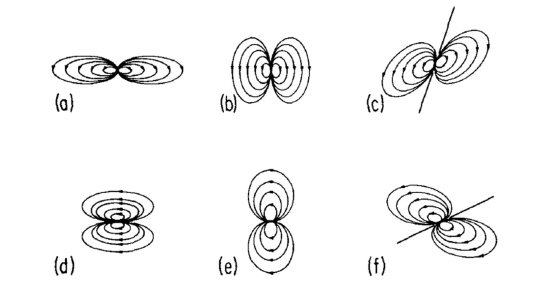

Radial gradients of absolute angular momentum of the primary circulation affect the radial scale of the dipoles just as the static stability affects their vertical scale. For a fixed static stability, the gyres tend to be elongated vertically when the inertial-stability parameter I2 is large and elongated horizontally when I2 is small. Vertical gradients of absolute angular momentum associated with the vertical shear of the primary circulation tilt the updraught through a heat source because the path of least resistance for the rising air lies along surfaces of constant absolute angular momentum. Likewise, horizontal temperature gradients associated with the vertical shear deflect the flow through momentum sources from the horizontal because the path of least resistance in this case lies along isentropic surfaces. Although the flow associated with a heat source lies generally along the M-surface and that associated with a momentum source lies generally along a θ-surface, in each case the flow does have a small component across the respective surface. It is the advection by this component that causes evolution of the primary circulation. It can be shown that the swirling flow remains in approximate gradient-wind balance provided the time scale of the forcing is longer than the orbital period of the primary circulation about the vortex centre.
It turns out that the induced secondary circulation in balanced flows tend to cancel the direct effect of forcing. For example, the work done by expansion in the updraught induced by a heat source nearly balances the actual heating so that the increase in temperature is relatively small. Similarly, a momentum source produces outflow that advects compensating low values of absolute angular momentum from the central region of the vortex.
Show now that the quantity D in Eq. (3.28) is proportional to the Ertel potential vorticity defined by Eq. (1.27). Hint: show first that for a symmetric vortex with tangential wind speed distribution v(r,z), ω + f = -(∂v/∂z)r-hat + (ζ + f)z-hat and ∇θ = -(1/χ2)∇χ = -(1/χ2)[(∂χ/∂r)r-hat + (∂χ/∂z)z-hat] so that

Show that the forcing term for φ can be expressed in terms of generalized buoyancy. Hint: show first that the forcing term in Eq. (3.26) can be written:

and deduce that that

Starting from the Boussinesq system of equations, show that the Sawyer-Eliassen equation takes the form

where B-dot is the source of buoyancy in the Boussinesq form of the thermodynamic equation and I2 is defined in Eq. (3.26).
The establishment of the Sawyer-Eliassen equation is an important step in formulating a balance theory for the evolution of an axisymmetric vortex. The assumption that the flow is balanced everywhere paves the way for a method to solve an initial-value problem for the slow evolution of an axisymmetric vortex forced by sources of heat (θ-dot) and tangential momentum (Fλ). Given an initial tangential wind profile vi(r,z) and some environmental density sounding ρ0(z), one would proceed using the following basic steps:
Solve Eq. (3.17) for the initial balanced density and pressure fields corresponding to vi(r,z).
Solve the Sawyer-Eliassen equation (3.27) for the streamfunction of the secondary circulation, φ, that keeps v and θ in thermal-wind balance for short time interval, Δt.
Solve for the velocity components u and w of the overturning circulation using Eq. (3.23).
Predict the new tangential wind field using Eq. (3.24) at time Δt.
Repeat the sequence of steps from item (1) to obtain the solution at time nΔt, where n is a positive integer.
The method is straightforward to implement numerically.
In principle it would appear equally acceptable at stage 4 to predict the (inverse) potential temperature via Eq. (3.25). However, this method is not recommended as there is no guarantee that a balance solution can be obtained everywhere for the corresponding gradient wind.
A number of issues arise in this type of model. First, as tropical cyclones intensify, the boundary layer and upper-tropospheric outflow region generally develop regions of zero or negative discriminant (D<0). A negative discriminant implies the development of regions supporting symmetric instability and technically speaking the global balance solution breaks down. Nevertheless, it is often possible to advance the balance solution forward in time to gain a basic understanding of the long-time balance flow structure. If, for example, the symmetric instability regions remain localized and do not extend throughout the mean vortex, one may apply a regularization procedure to keep the Sawyer-Eliassen equation elliptic and thus solvable.
A particularly important issue is that of how to formulate the forcing terms in the Sawyer-Eliassen equation, i.e. the diabatic heating rate and the near-surface frictional force. The representation of diabatic heating in terms of the evolving flow constitutes the cumulus parameterization problem discussed in chapter \ref{Intense}. Typically, this requires the inclusion of a prediction equation for water vapour and, in more sophisticated representations, for various species of water condensate. The representation of friction is examined in the next chapter.
Having shown that any steady vortical flow with velocity field u = (0,v(r,z),0) is an exact solution of the inviscid equations without secondary circulation or heating, it is appropriate to ask under what circumstances such solutions are stable. We consider here the problem of local axisymmetric stability based on simple parcel arguments. Other aspects of vortex stability will be discussed later.
For simplicity, we begin by considering a barotropic vortex rotating with tangential velocity v(r) in an incompressible fluid. Solid body rotation is the special case v(r) = Ωr, where Ω is the constant angular velocity. The approach is to investigate the forces acting on a fluid parcel that is displaced radially outwards from A at radius r1 to B at radius r2 in Fig. 3.8.
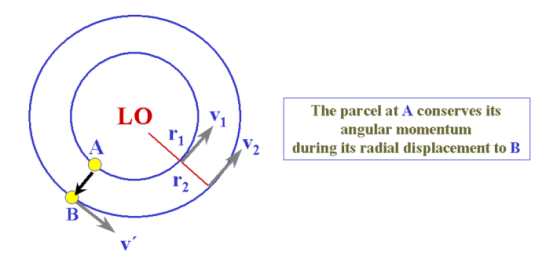
Assuming frictional torques can be neglected, the parcel conserves its absolute angular momentum so that its velocity v' at B is given by

Other parcels at the same radius as B have a velocity v2 that is different, in general, from v'. In equilibrium, these parcels are in a balanced state in which the radially-inward pressure gradient force they experience is exactly balanced by the outward centrifugal force; i.e.,

It is assumed that the disturbance brought about by the displaced parcel at radius r2 can be neglected. Now, the displaced parcel will experience the same radial pressure gradient as other parcels at radius r2, but since it rotates with velocity v', the sum of the centrifugal and Coriolis forces acting on it are v'2 /r2 + fv'. Therefore, the displaced parcel experiences an outward} force per unit mass,
Other parcels at the same radius as B have a velocity v2 that is different, in general, from v'. In equilibrium, these parcels are in a balanced state in which the radially-inward pressure gradient force they experience is exactly balanced by the outward centrifugal force; i.e.,

Using (3.34) and (3.35), this expression can be written after a little algebra (Exercise 3.7) as

Recognizing the term inside the main parentheses as the absolute angular momentum we may rewrite (3.36) as follows

Therefore an air parcel displaced outwards experiences an inward force (i.e. a restoring force) that is proportional to the difference in the absolute angular momentum squared between the two radii.
For small displacements from the initial equilibrium position one may expand the expression for the net outward force as a Taylor series, retaining only the first order term in the displacement r' = r2 - r1. The net outward force per unit mass acting on the displaced parcel is then approximated by

where it is understood that the equilibrium quantities above are evaluated at the initial position. This expression enables us to establish a criterion for the stability of a general rotating flow v(r), analogous to the criterion in terms of sgn(N2) for the vertical stability of a density stratified fluid at rest. It follows from (3.38) that a general swirling flow v(r) is stable, neutral or unstable if the radial gradient of the square of the absolute angular momentum is positive, zero, or negative. The height-radius distribution of the quantity M for the baroclinic vortex in Fig. 3.4 is shown in Fig. 3.5 and that for M2 is shown in Fig. 3.9.

For the special case of solid body rotation, v = Ωr, and for a small displacement from radius r1 = r to r2 = r + r', (3.22) gives

Thus, an air parcel displaced outwards experiences an inward restoring force, proportional to the displacement and to the square of the absolute angular frequency Ω + ½f. Likewise, a parcel displaced inwards experiences an outward force, again a restoring force. This result is in direct analogy with the restoring force that acts on a fluid parcel when it is displaced vertically in a stably-stratified, non-rotating fluid. Note that if the rotation rate Ω >> ½f, such as in a rotating tank in the laboratory, the rotation of the coordinate system cannot be neglected generally and F ≈ -4Ω2r' (see below for more on this point).
The presence of a restoring force when an air parcel is displaced radially in a rapidly-rotating fluid leads to the concept of centrifugal or inertial stiffness. Broadly speaking, the larger the rotation rate, the harder it is to displace an air parcel radially. A notable exception to this 'rule of thumb' occurs for tangential wind profiles exhibiting a 1/r decay law with radius.
In order to generalize the above to a compressible atmosphere, one must incorporate the variable density in the local force balance arguments. Before considering the general compressible case, it is helpful to first recall how rotating flows of incompressible fluid are represented in the laboratory. Here the bulk fluid rotates at some specified rotation rate ω about the vertical axis and (as is customary in meteorology and oceanography) the fluid equations are usually written in the frame of reference rotating with the vessel as a whole. Here the centrifugal force per unit mass ¼f2rr-hat, where r-hat is the radial unit vector, arising from the representation of the absolute acceleration in the rotating system must be added to the right-hand side of the radial mometum equation for a complete force balance (3.1). In view of Fig. 3.1, rather than absorb this centrifugal force term into gravity, one instead combines this centrifugal term with the radial pressure gradient. The combined terms define a modified pressure gradient force, but in the absence of free-surface effects the centrifugal force associated with the accelerating reference frame plays no further role in the ensuing fluid dynamics. The modifed pressure Pm is defined as

and represents the sum of the hydrodynamic pressure and the centrifugal force per unit volume arising from the bulk fluid rotating as a solid body. In the absence of relative motion, the modified pressure reduces to a hydrostatic pressure that balances the weight of fluid per unit area above a particular height plus a vertically uniform 'reaction pressure' that is exerted by the walls of the vessel in order hold the fluid in dynamic equilibrium..
For the case of a compressible fluid, in which the variation of density cannot be neglected, the centrifugal acceleration of the coordinate system can no longer be buried in the modified pressure gradient. In this case it sometimes proves insightful to return to the absolute (inertial) coordinate system. This proves advantageous in the local stability analysis for a fully compressible vortex and we adopt this approach here.
Referring to Fig 3.1 and Exercise 3.3, and assuming an ideal gas law for an equation of state, a useful first step is to recast the axisymmetric gradient wind and hydrostatic balance equations in terms of the Exner function. As discussed above, for completeness we will include the centrifugal force term in the radial momentum equation:

In terms of the absolute tangential velocity va = v + ½rf the radial momentum equation simplifies to

Equation (3.42) is sometimes called the 'cyclostrophic balance' equation, but since the ambient rotation rate of the frame of reference and the relative rotation of the swirling flow are both included we will call it the generalized gradient wind balance equation.
Since (3.41) and (3.42) express the partial vertical and partial radial derivatives of the Exner function, a consistency condition among them may be extracted upon taking the partial radial derivative of the hydrostatic equation in (3.41) and the partial vertical derivative of the generalized gradient balance equation (3.42), and equating the two expressions. This then furnishes

a \textit{generalized thermal wind equation} for a gaseous baroclinic vortex (cf. (3.12)). This equation will prove useful when interpreting the stability criteria of a compressible baroclinic vortex.
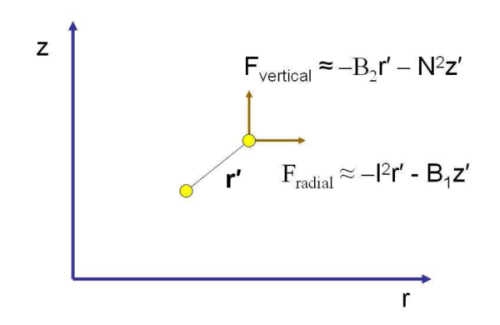
In light of the above preliminary considerations the simple stability theory will now be extended to the case of an initially-balanced baroclinic vortex in a stratified compressible atmosphere. No density approximation of any sort will be invoked. We consider then the displacement of an air parcel (equivalent to a ring of fluid) from an initial point ri = (ri, zi) to a neighbouring point r = ri + r', z = zi + z') (see Fig. 3.10). Before displacement, the swirling flow exactly satisfies gradient and hydrostatic balance; the corresponding pressure, density and temperature fields comprising this balanced equilibrium are denoted here by an overbar. The air parcel's initial and final densities are ρi and ρ, its initial and final elemental volumes are {δV}i and δV, and its initial and final mass are {δm}i and δm, respectively. When the parcel arrives at the new position r, it must preserve its initial mass. That is, {δm} = {δm}i.
In the parcel's frame of reference, we may apply Newton's second law in the radial direction provided the net centrifugal force is added to the force balance. At the new radial position we have:

where Va is the absolute tangential velocity defined above. Adhering to the parcel formalism, it will be assumed that pressure fluctuations during the parcel's displacement can be ignored. Hence, p(r) = p-bar(r) and the pressure gradient appearing on the right hand side of (3.44) will be evaluated using the equilibrium pressure field. (Recall that the equilibrium pressure field is in \textbf{generalized?} gradient wind balance with the swirling wind \bar Va.)
The net radial force on the displaced parcel (ring) is then

Recalling the ideal gas equation p = ρR T and the definition of potential temperature θ = T (p**/p)κ, the density can be expressed as

where \gamma = cpd/cvd, etc. Assuming that there is no heat loss or gain during the parcel's displacement, then the potential temperature of the parcel will be conserved implying that θ(r) = θ-bar(ri). For the case of a saturated moist atmosphere, the saturation equivalent potential temperature is the proper 'adiabatic invariant': see Exercise 3.6.
The mean and parcel densities at the displaced position are thus

and

Using (3.48), together with (p(r) = p-bar(r)) and (θ(r) = θ-bar(ri), the needed density ratio

The net radial force (3.45) is thus

Now because the flow is here assumed to evolve axisymmetrically, the parcel must conserve its absolute angular momentum during its displacement, i.e., M(r) = M-bar(ri) (see section 3.1). This simplifies the radial equation of motion to

It should be noted that apart from the customary parcel approximation, Eq. (3.51) is exact. A similar analysis may be completed for the parcel's vertical motion. Briefly, when the parcel is displaced from rito r the vertical momentum equation at the new position is

Using the ambient pressure p-bar(z) to compute the vertical pressure gradient, the net vertical force is

Because the swirling flow satisfies hydrostatic balance (∂p-bar/∂z = -ρ-bar g), Equation (3.53) becomes

The net upward force is thus the difference between the weight of the fluid parcel and the weight of the displaced fluid (Archimedes principle). Dividing through by the mass element (δm = ρδV) furnishes

Recalling (3.49), Eq. (3.55) may be rewritten in terms of the equilibrium potential temperature and its derivatives

Now, for small displacements (i.e., |r'| << |ri|) , local stability criteria may be derived on approximating the above two stability equations (3.51) and (3.52) in a Taylor series and neglecting second and higher order terms in the displacement field. To wit: The radial momentum equation is approximated by the following linearized stability equation:

it being understood that all quantities involving the equilibrium flow are evaluated at the initial position ri. Given the nature of Eq. (3.57), the two derivative terms physically represent radial and vertical contributions to the centrifugal buoyancy, respectively.
The corresponding stability equation for the vertical motion is obtained in an entirely analogous way. Omitting details, the result is:

In analogy with (3.57), the two derivative terms on the right hand side represent the radial and vertical contributions to gravitational buoyancy, respectively. Together, the four mean flow terms appearing in Eqs. (3.57} and (3.58) comprise what is called the vortex stability tensor and the stability/instability criteria for the baroclinic vortex may be deduced knowing the invariant properties of this tensor. Here we pursue a direct approach and consider the solution properties of the two stability equations.
Equations (3.57) and (3.58) are a pair of ordinary differential equations for the parcel displacement ri = (r', z'). Let

The height-radius distributions of the quantities N2, I2, B1 and B2 for the vortex in Fig. 3.4 are shown in Fig. 3.11. Note that for a vortex in which the tangential wind speed decreases with height, B1 and B2 are typically negative and contribute to force perturbations in the direction of the displacement, as sketched in Fig. 3.9.

If the quantities N2, I2, B1 and B2 are appreciably constant on the scale of a parcel displacement, Eqs. (3.57) and (3.58) have solutions of the form (r',z') = (r'0,z'0) exp(iωt), where r'0 , z'0 and ω are constants and the frequency ω satisfies the pair of equations:

These have a solution for (r'0,z'0) only if

or

Then

Note that the expression under the square-root sign can be rewritten as (N2 - I2) + 4B1B2 and it is always positive if B1B2 > 0 (see Exercise 3.6). Then the solutions for ω2 are both positive provided that the magnitude of (N2 + I2) is larger than the square root term, i.e. if the discriminant δ = (N2 + I2) - [(N2 - I2) - 4B1B2] = 4(N2I2 - B1B2) is positive. In this case the parcel oscillates along the (r'0,z'0) with frequency ω given by (3.62) and the flow is stable. On the other hand, if δ < 0, one solution for ω2 is negative. In this case, two solutions for ω are imaginary and one of these gives an exponentially growing solution for the parcel displacement. In this case a displaced parcel continues to move away from its initial position and the displacement is therefore unstable. We refer to this situation as symmetric instability.
It is left for the reader to show that the sign of δ is equal to the sign of the potential vorticity, q, divided by the absolute angular rotation rate ½\xi = V/r + ½f (see Exercise 3.4). Note that V > -½fr is required for gradient wind balance to exist in anticyclonic flow (∂p/∂r > 0). Solving the equation for gradient wind balance gives: v = -½rf + √[¼r2f2 + (1/ ρ)(∂ p/∂ r)], where the positive sign is chosen so that the expression reduces to that for geostrophic balance at large radial distances. Then v cannot exceed ½rf in magnitude. If, however, ∂p/∂r = 0, a balanced solution is possible with v = -rf in which C = 0 and the Coriolis force is balanced by the centrifugal force. The height-radius distributions of the the discriminant δ for the vortex in Fig. 3.4 is shown in Fig. 3.11.
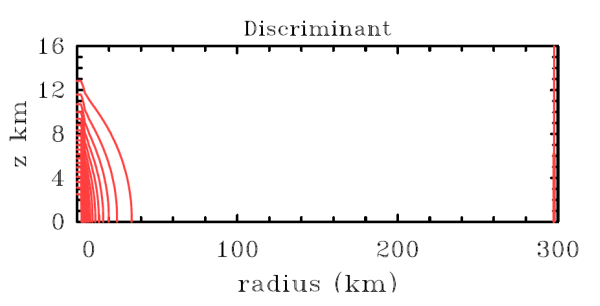
The trajectory of a particle can be obtained as follows. Suppose that the flow is symmetrically stable and that the initial parcel displacement is to the point (r'0,z'0). Let ω1 and ω2 be the eigenfrequencies given by Eq. (3.62). From (3.60), the corresponding eigenvectors are: (1,(ω12 - I2)/B1) and (1, (ω22 - I2)/B1). Then the parcel displacement at time t may be written as

where c1± and c2± are four constants. At t = 0, (r'(t),z'(t)) = (r'0,z'0) and we assume that the particle has no initial motion: (dr'/dt,dz'/dt) = (0,0). These conditions determine c1± and c2±. The second condition gives us c1- = c1+ = ½c1- and c2- = c2+ = ½c2- so that if both values of ω2 are positive, Eq. (3.63) becomes

This equation gives c_1 + c_2 = r'_0 and c_1(ω_1^2 - I2) + c_2(ω_2^2 - I2) = B1z'_0, from which,

Finally

and

An example of an air-parcel trajectory in a symmetrically-stable rotating shear flow is shown in Fig. 3.13a and one that is in a symmetrically-unstable flow is shown in Fig. 3.13b.
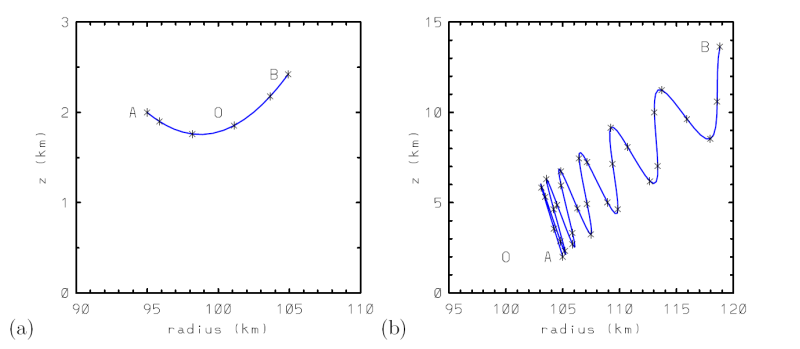
Work out the axisymmetric stability of a moist compressible vortex that is initially in gradient and hydrostatic equlibrium. Assume for simplicity that the vortex is everywhere moist saturated.
Show that

and

where

Show also that

and that

Starting with the expressions for B1 and B2 in the previous exercise, show that

and that within the framework of the Boussinesq approximation B1 = B2.
Show that the potential vorticity for the vortex v(r,z) is

Deduce that

Show that ∇θ ∧ ∇M is proportional to the potential vorticity, i.e. to I2N2 - B1B2. Show that this quantity is negative when the θ-surfaces are more steeply inclined to the horizontal than the M-surfaces. Note that this configuration of M- and θ-surfaces is therefore a condition for symmetric instability. Note also that the alignment of the M- and θ-surfaces implies zero potential vorticity.
Show that in the symmetrically-unstable case, the terms involving cos(ω2t) in Eqs. (3.67) and (3.68) must be replaced with cosh(ω*2t), where ω*2 = - ω2.
Tropical cyclones are rapidly-rotating warm-cored vortices and the warm core is therefore positively buoyant relative to the environment. However, we have seen that on the cyclone scale, hydrostatic and gradient-wind balance exist to a good approximation and the radial density (or buoyancy) gradient is related by the thermal-wind equation to the decay in the mean tangential circulation and density with height. Clearly much of the radial gradient of buoyancy force cannot be thought of as being ``available'' for ``driving'' a secondary (or toroidal) circulation of the vortex that is necessary for vortex amplification. Nevertheless, hydrostatic balance may be a poor approximation in individual convective clouds and a pertinent question is whether these clouds have significant local (unbalanced) buoyancy, which in turn might play an important role in the dynamics of storm intensification. To address this question it is necessary to define the perturbation pressure and perturbation density relative to some vortex-scale pressure and density distributions. The simplest case is when the primary vortex is approximately steady and axisymmetric. Then we may take reference distributions pref(r,z) and ρref(r,z), respectively, that are in thermal wind balance with the tangential flow field v(r,z). We saw how to do this in section \ref{PrimCirc} using the method of characteristics. We may use ρref(r,z) and pref(r,z) as alternative reference quantities to define the buoyancy force in Eq. (1.26) without affecting the derivation of this equation. We denote the generalized buoyancy force so calculated by bB. It follows that bB ≡ 0 in the axisymmetric balanced state, whereas, if the reference pressure and density at r = R are used, b equals some nonzero function b0(r,z). Clearly, the partition of force between perturbation pressure gradient and buoyancy will be different for the reference state characterized by ρ0(r,z) and p**(r,z) and interpretations of the dynamics will be different also, albeit equivalent to those using the more conventional reference quantities that depend on height only.
In the more general case, when the vortex structure has marked asymmetries and/or is evolving in time, it is necessary to allow for the azimuthal and/or time variations of the reference state.
Axisymmetric balanced models of tropical cyclone intensification appear to capture many important observed features of tropical cyclone behaviour. However, in an axisymmetric model that assumes exact thermal wind balance, bB(r,z,t) ≈ 0 and the corresponding ∂p'/∂z≈ 0, even though there may be heat sources or sinks present that generate buoyancy b. It is clear from the foregoing discussion that any diabatic heating or cooling in such models is incorporated directly into the balanced state, changing b(r,z,t), while bB(r,z,t) remains identically zero by definition. Obviously, nonzero values of bB relate to unbalanced motions provided that the appropriate reference state as defined above has been selected for the definition of buoyancy at any given time. It may be helpful to think of b as characterizing the system buoyancy and bB as characterizing the local buoyancy.
The λ-component of vorticity, or toroidal vorticity is

The equation for η is derived as follows. Consider

This expression may be written

where, for completeness frictional stresses Fu, Fw, are included in the momentum equations. This equation reduces to

Now

so that

Then

Again

but the continuity equation now gives

where D/Dt ≈ ∂/∂t + u ⋅ ∇. Thus the toroidal vorticity equation is

or

The Sawyer-Eliassen equation is an approximate form of the local time derivative of equation for the toroidal vorticity η = ∂u/∂z - ∂w /∂r. Assuming the most general form of the continuity equation

equation is the toroidal vorticity equation may be written as

η /(r ρ) is a 'potential toroidal vorticity', where the analogous `depth' is `r', the radius of a toroidal vortex ring (see appendix). If thermal wind balance exists, the right-hand-side of (3.71) may be written as

Then the time derivative of (3.71) is

The right-hand-side of (3.72) gives the Sawyer-Eliassen equation when the thermal wind equation (3.11) is satisfied for all time. Then consistency requires that the left-hand-side is identically zero.
In section \ref{Balvor} we outlined an approach to understanding and calculating the evolution of a tropical cyclone based on the Sawyer-Eliassen equation for the balanced overturning circulation forced by heat and momentum sources. An alternative approach is to use the pressure tendency equation. The latter approach for describing the balanced evolution of a vortex has a number of advantages over the use of the Sawyer-Eliassen equation. To begin with, unlike the Sawyer-Eliassen equation, the derivation is not degenerate for the steady state. A mathematical advantage of using the pressure tendency equation is that it avoids the need to first invert for the overturning circulation, then advect the tangential wind component by the radial and vertical flow, and finally to link the changes in tangential wind to changes in the mass field by solving the thermal wind equation. In fact, for an idealized vortex, the pressure tendency equation gives a direct link between the heat and momentum forcing to the changes in the mass field of the vortex.
The pressure tendency equation is derived as follows. Instead of eliminating the pressure tendency in the time derivative of the thermal wind equation as in the derivation of the Sawyer-Eliasson equation, the first step is to use the hydrostatic and gradient wind balance equations to express C and χ in terms of the function \Pi, where \Pi = c_p\pi. The next step is to solve the new forms of the tangential momentum and thermodynamic equations for u and w. Finally, substitution of the expressions for u and w in the continuity equation yields the desired equation for ∂ \Pi / ∂ t, or equivalently for ∂ p / ∂ t. The algebraic details of the derivation are a little messy and are relegated to an appendix. The result may be written

where

is called the spin-up function. Like the Sawyer-Eliassen equation, it can be shown that Eq. (3.73) is an elliptic equation when the discriminant
is positive.

Latest version: Munich 1 August 2013